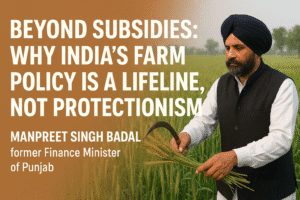Beyond Subsidies: Why India’s Farm Policy is a Lifeline, Not Protectionism
India’s farm policy is a vital lifeline for 700 million vulnerable citizens, not unfair protectionism. While contributing 16% to GDP, agriculture underpins social stability and cultural identity for half the population. Dismantling safeguards like Minimum Support Price (MSP) amid massive US/EU farm subsidies – $20 billion and €387 billion respectively – would unleash devastating “asymmetric warfare” on global markets.
Western systems overwhelmingly support large agribusiness (80% of subsidies), whereas India uniquely targets smallholders. Crucially, the EU now acknowledges this imbalance by capping subsidies to redirect support toward smaller farms, validating India’s approach. Forcing India into a “free-for-all” while developed nations distort markets risks economic ruin for millions, rural collapse, and irreversible social upheaval. India’s stance defends equitable survival against hypocritical demands for unilateral disarmament.

Beyond Subsidies: Why India’s Farm Policy is a Lifeline, Not Protectionism
Manpreet Singh Badal, a farmer and former Finance Minister of Punjab, cuts through simplistic economic arguments with a stark warning: forcing India to dismantle its agricultural safeguards isn’t just bad economics – it’s a potential catalyst for profound social and cultural upheaval. His perspective, grounded in both soil and policy, reveals why India’s approach is fundamentally different and necessary.
The Human Scale Beyond GDP
While agriculture contributes 16% to India’s GDP, this figure is a shallow metric. It hides the reality that 250 million people farm directly, and a staggering 700 million Indians – over half the population – depend directly or indirectly on agriculture and the rural economy. For these millions, farming isn’t merely an industry; it’s a survival mechanism intricately woven into the nation’s social, political, and cultural fabric. Protecting this sector isn’t policy preference; it’s existential.
Subsidy Smokescreens: A Global Double Standard
The core argument against India’s Minimum Support Price (MSP) system often ignores global realities:
- Everyone Does It, Differently: The US and EU employ complex, costly support systems analogous to MSP.
- USA: Uses an “Effective Reference Price” (ERP). If market prices dip below ERP, farmers receive direct payments (“Price Loss Coverage” – PLC or “Agriculture Risk Coverage” – ARC) covering 22 major crops. Dairy also gets support via Dairy Margin Coverage (DMC). Total spend: ~$20 billion annually.
- EU: Its Common Agricultural Policy (CAP) provides massive direct income support (~€387 billion for 2021-2027) when prices fall below intervention levels. Recent reforms even try to cap subsidies (€100,000/farmer/year) to shift support towards smaller farmers, mimicking India’s focus.
- Transparency vs. Complexity: India’s MSP involves transparent government procurement. The US/EU models rely on intricate direct payments, requiring significant farmer literacy and administrative bureaucracy – a challenging transition for India’s vast smallholder base.
- Who Benefits? A Stark Contrast:
- US/EU: Roughly 80% of subsidies flow to large farms.
- India: Roughly 80% of support targets small and marginal farmers.
- EU’s Pivot: Notably, the EU is actively trying to move away from the US model of subsidizing large agribusiness and towards supporting smaller holdings, recognizing the value India has long placed on this.
The Asymmetry Trap: Why “Free-for-All” Fails
The pressure on India to scrap MSP and reduce tariffs ignores this critical asymmetry. Demanding India unilaterally disarm its farm support while the US and EU maintain massive, market-distorting subsidies creates inherently unfair competition. It’s not a level playing field; it’s “asymmetric warfare” in global trade.
Opening India’s agriculture under these conditions wouldn’t foster healthy competition; it would flood the market with artificially cheapened produce from heavily subsidized foreign farms. Indian smallholders, lacking comparable financial buffers or scale, would be decimated. The consequences?
- Economic Shock: Collapse of rural incomes, exacerbating poverty.
- Social Instability: Massive displacement and unemployment among 700 million connected individuals.
- Cultural Erosion: The disruption of deeply rooted agrarian communities and ways of life.
A Matter of Survival and Sovereignty
As Badal emphasizes, India’s stance, echoed by Prime Minister Modi, is not stubborn protectionism but a necessary defense of its unique socioeconomic structure and the survival of its most vulnerable citizens. India seeks “equitable and development-centred agreements” that acknowledge:
- Context Matters: MSP is tailored to India’s reality of millions of small farms. CAP/PLC are tailored to the EU/US context of large-scale commercial agriculture.
- Subsidies Distort: Western subsidies fundamentally skew the global market.
- Human Cost is Paramount: The potential human cost of reckless liberalization vastly outweighs abstract market principles.
The debate cannot be reduced to simplistic cries of “free trade” versus “protectionism.” It’s about acknowledging the vast subsidies propping up Western agriculture and the devastating, real-world impact forcing India to abandon its carefully calibrated, small-farmer-focused lifeline would have. The stability of India‘s vast rural heartland depends on policies that recognize its unique vulnerabilities in an uneven global playing field. The EU’s own recent shift towards supporting smaller farms underscores the validity of India’s long-held approach. Fairness, equity, and the survival of millions demand nothing less.
You must be logged in to post a comment.